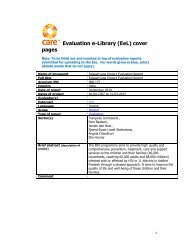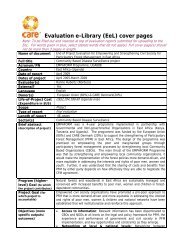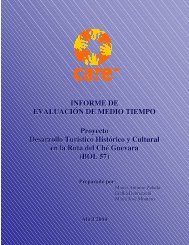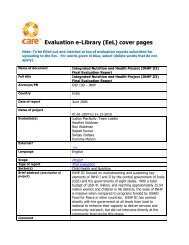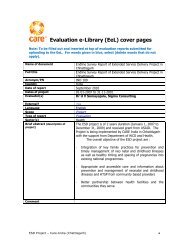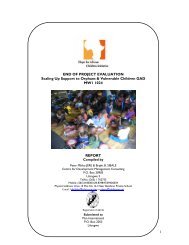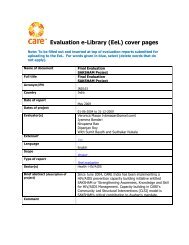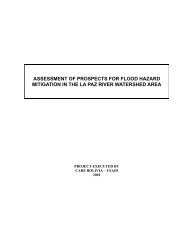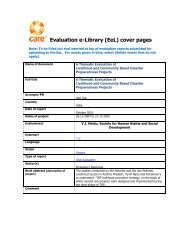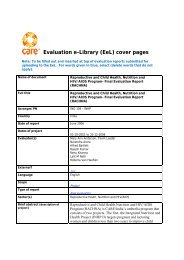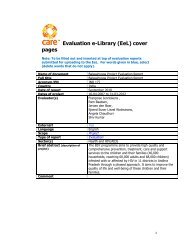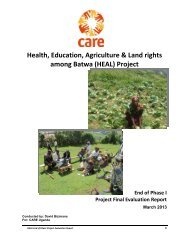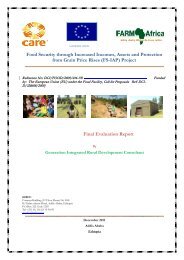IND 199 ECDE Baseline - CARE International's Electronic ...
IND 199 ECDE Baseline - CARE International's Electronic ...
IND 199 ECDE Baseline - CARE International's Electronic ...
- No tags were found...
Create successful ePaper yourself
Turn your PDF publications into a flip-book with our unique Google optimized e-Paper software.
xxviiFrom Table 4.11, the following findings have emerged.• More than four- fifths of the respondents (84% in intervention and 87% in intermediateAWCs) and 44 percent in control district had expressed their knowledge of holding NHDsat AWC• Regarding their participation in NHDs , 62 percent in intervention districts (55% in Janjgirand 69% in Korba district) replied in affirmative. The corresponding figure in controldistrict was 52 percent.• Regarding type of activities undertaking on NHDs, almost all of them reported“immunization of children (96-97%).4.3.2 Utilization of services at AWCs4.3.2.1 Receipt of supplementary nutrition foodAll the surveyed respondents were asked whether the mothers received supplementarynutrition from AWC during their pregnancy. Those who received supplementary nutrition fromAWC were further asked about nature of nutrition received and its consumption pattern. Table4.12 provides such information.Table 4.12: Receipt of supplementary nutrition from AWCs during the last pregnancy(Percentage)Particulars Intervention districts Control districtInterventionAWCsIntermediateAWCsControlAWCsWhether received supplementarynutrition (n=) 828 844 924Yes 83.8 85.3 87.8No 16.2 14.7 12.2Nature of nutritionreceived (n=) 694 720 811Cooked meal 22.9 27.2 4.3Take home ration 76.5 72.5 94.9Not specified 0.6 0.3 0.7Usually eaten all the givenfood (n=) 694 720 811Yes 29.8 29.4 28.1No 70.2 70.6 71.3Not specified 0 0 0.6The following main findings have emerged.• As high as 85 percent of the mothers in intervention districts [higher in korba (91%) thanJanjgir (79%)] and 88 percent in control district reported to have received supplementarynutrition from AWC.• About three – fourths of the mothers in intervention districts received “take home ration”.The proportion of such mothers was higher in Janjgir (92%) than in korba (58%),whereas in control district, 95 percent reported to have received such a ration.• Slightly less than 30 percent of the mothers in both intervention districts (29.6%) andcontrol district (28%) of those who received supplementary nutrition ate all the foodreceived by them. The proportion of such mothers was higher in korba (49%) than inJanjgir (8%). About two - fifths of the mothers in korba district received “cooked food”and that is why the consumption of food was higher in this district.<strong>Baseline</strong> Study Of Early Childhood Care And Development Project In ChattisgarhApril,2012



